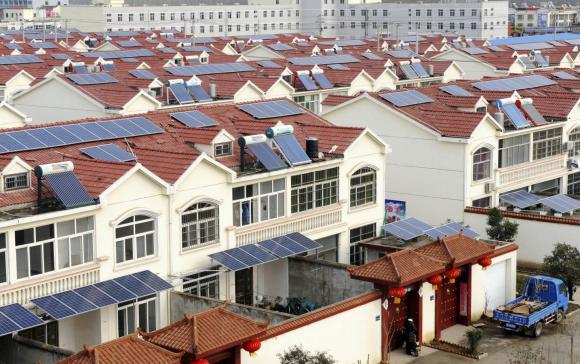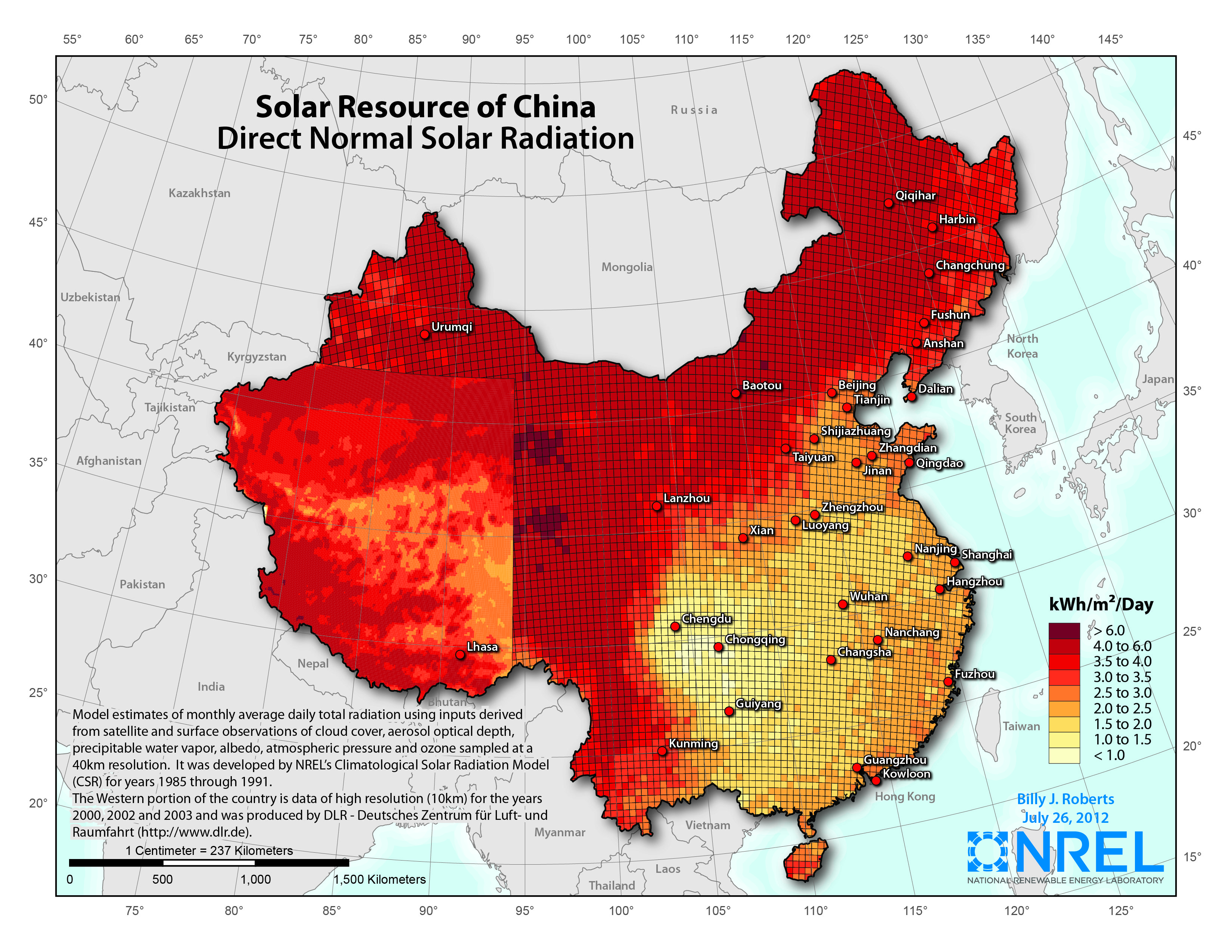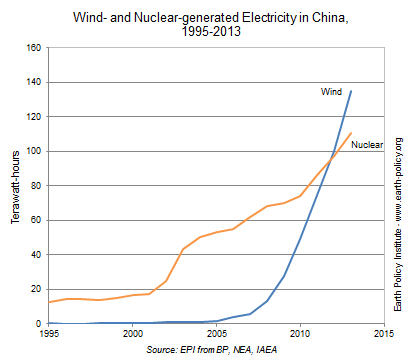
China’s government tends to be ruled by a high degree of economic realism. The national economy comes first and has largely trumped other considerations, such as the environment, human rights, democracy, global public opinion, etc. The decision to enter into the climate pact with the U.S., to the extent that China intends to honor it (and there is no indication at this stage that it does not), suggests that it has to give serious consideration to how it will meet the lofty objective implied by the commitment to provide 20% of its total energy supply through low-carbon generation sources by 2030. It is being reported widely that this objective equates to China installing as much low-carbon generation as the entire current U.S. electricity production from all sources.
It’s completely reasonable to wonder, with such an ambitious goal, how much China will rely on nuclear as opposed to renewables to get there. In fact, there is no reason to expect that China will abandon nuclear, given all the rest of the reasons the country has been pursuing it: building of international prestige, demonstration of geopolitical might, illustration of engineering prowess, development of manufacturing capacity, etc.
But in reality there is no way that nuclear is going to be even close to a majority share of how China will get to the goal. China will soon have 22 reactors in operation and has the largest pipeline of reactors in construction in the world at a whopping total of 27. There are reportedly another 59 reactors in the planning stage, and 150 reactors proposed. These numbers are very similar to the historical U.S. reactor pipeline, which once approached a high of about 250 reactors proposed, planned, or developed. The U.S. fell short by more than half that number. capping out at 114 commercial reactors completed (15 of which are closing or closed), plus the five currently in construction.
If every one of these were actually built and put into operation, China’s ambitious nuclear development plans would cap out at about 250,000 MW of nuclear generation–more than 10 times the reactors and 12 times its current nuclear power capacity. And China would do this in about the same amount of time it has taken to develop just the 22 reactors currently in operation–an incredibly ambitious expansion under the huge constraints facing nuclear energy development. Essentially, China would have to build and put into operation 15 reactors/year for 15 years, more than one per month.
Currently, China only has firm(-ish) project completion dates for 36 reactors through 2020. On average, it seems to be taking China at least five years to complete construction of reactors once started. In order to meet the necessary development rate to keep pace, China would need to have about 75 reactors under construction now to be completed by 2020. So, thus far, it looks like China is only preparing to move at half the pace necessary to build all these reactors by 2030. This means that perhaps only 130 reactors would be in operation by then–surpassing the US handily, yes, but still falling well short of what would be necessary to make a dent in the goals China just committed to.
The U.S. electricity industry had a total of 1,167,995 MW of generation capacity in 2012. China’s total nuclear development pipeline does not even get the country 25% of the way there. With an average reactor size of 1,100 MW, China would have to build over 1,000 reactors in 15 years to meet all of its goal with nuclear–more than double the total number of reactors built worldwide in the last 60 years, and nearly 30 times more than the country’s current development pipeline. To get to even 50% of the goal with nuclear would not be much less daunting–over 500 reactors. China’s most ambitious plans so far only get them to 25% of the goal, and a sober assessment of where the country is in developing the pipeline puts them at only about 12.5%. That would make nuclear about 2.5% of the country’s energy mix in 2030, all but inconsequential.

The upshot of all this arcane number-crunching is that China must be assuming it will rely heavily on renewables to do the job. It can’t expect to build that many more reactors that much more quickly than it has been. And in the course of undertaking this plan, it will have to contend with the higher cost of nuclear–even at China’s inevitably lower cost levels than the West, due to wage rates, government subsidies, and other issues. nuclear is still an expensive source of power. There is just no way China is going to be able to meet this goal by relying on nuclear as a major component of it, and the government must reconcile itself with that fact.

And while there is no doubt that China will continue with its nuclear program, the natural question is: why? China has to be looking at its capacity to develop solar and wind, at immensely lower cost than nuclear, much more rapidly, and with much greater economic potential for exports and global market share. Why waste all the economic resources on such a small part of its energy strategy, when it could direct it more efficiently and reliably and productively into renewables? The country has been bringing more wind and solar online than nuclear in recent years–surpassing 100,000 MW of wind already and nearing 35,000 MW of solar–even though it has longer experience with nuclear than it does with renewables. China will likely continue its nuclear development program, but for other, less admirable reasons. But nuclear won’t be a major portion of meeting its commitments under this climate agreement.
And here’s the trick. If China can build as much renewable electricity generation in 15 years as it takes to power the entire U.S.–then why can’t the U.S. do it? The U.S. has more land area, more coastline, no less sun, and all of the other natural resources that power renewable energy systems. It’s not clear whether the Obama administration asked that question during the last year of negotiations with China, but if so, the administration’s own commitment and EPA’s carbon rule don’t show it.
As climate change deniers, skeptics, and cynics downplay or even attempt to scuttle the agreement, it’s essential not to lose sight of this basic point. China just pulled the curtain on the fact that the U.S., and the rest of the world, can get to a low-carbon economy within the 2050 timeframe AND that we can do it without nuclear. It’s yet to be seen whether China can get there, since its growth in total energy use is so rapacious and the commitment is just to cap emissions growth by 2030. And similar concerns can be raised about India, which has been starting on a similar economic trajectory as China. But the U.S. is still the second-largest carbon emitter (and by far the largest per capita), accounting for 15% of global CO2 emissions. And even if everyone but China and India could get to zero emissions–and those two countries got to some meaningful reductions–that would probably still get the world to better than 80% reductions by 2050. That may be the most hopeful sign we’ve seen on climate action since, well, the People’s Climate March.
Tim Judson
Tim Judson is executive director of Nuclear Information and Resource Service
November 13, 2014
Permalink: https://www.nirs.org/2014/11/13/the-inconvenient-truth-in-us-china-climate-pact/
Your contributions make publication of GreenWorld possible. If you value GreenWorld, please make a tax-deductible donation here and ensure our continued publication. We gratefully appreciate every donation of any size.
Comments are welcome on all GreenWorld posts! Say your piece above. Start a discussion. Don’t be shy; this blog is for you.
If you’d like to receive GreenWorld via e-mail, send your name and e-mail address to nirs@nirs.org and we’ll send you an invitation. Note that the invitation will come from a GreenWorld@wordpress.com address and not a nirs.org address, so watch for it.
If you like GreenWorld, you can help us reach more people. Just use the icons below to “like” our posts and to share them on the various social networking sites you use. And if you don’t like GreenWorld, please let us know that too. Send an e-mail with your comments/complaints/compliments to nirs@nirs.org. Thank you!
GreenWorld is crossposted on tumblr at https://www.tumblr.com/blog/nirsnet



